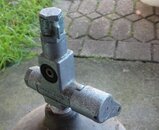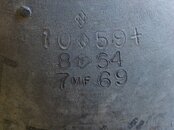I trained back in the day with a J valve and always thought it a good idea. I know we are supposed to check our air pressure regularly, but once years ago, I got so engrossed in the survey of a wreck that I didn't pay attention to my air until I felt that difficulty breathing. I was down to 500 lbs, pulled the rod, and had plenty of air to.get back up. If I hadn't had the J valve, I would have probably had to buddy breathe to the surface. Today, you can't get a dive shop to touch a tank that has one. Why would they fallen into such disfavour?
You are using an out of date browser. It may not display this or other websites correctly.
You should upgrade or use an alternative browser.
You should upgrade or use an alternative browser.
J valve
- Thread starter 2MADAKAT
- Start date
Please register or login
Welcome to ScubaBoard, the world's largest scuba diving community. Registration is not required to read the forums, but we encourage you to join. Joining has its benefits and enables you to participate in the discussions.
Benefits of registering include
- Ability to post and comment on topics and discussions.
- A Free photo gallery to share your dive photos with the world.
- You can make this box go away
Dizzi Lizzi
Contributor
I have one. No prob with fills or VIP. I don't use it as a J valve though, I just keep it in the down position.
I trained on them as well; and I still have Dacor and Voit 62s with J-valves; though, one has since been disabled, and now functions conventionally. Both were inherited; date originally from 1959; and are still routinely filled.
I imagine that they fell into disfavour, for the very experience that you just described; that and the then burgeoning availability of SPGs. There tended to be a false sense of security with J-valves. I too had a similar experience years ago; and had to do my first and only actual controlled ascent from about 20 meters as a result, and knew of an instance where the reserve had been inadvertently tripped; and there had been a close call . . .
I imagine that they fell into disfavour, for the very experience that you just described; that and the then burgeoning availability of SPGs. There tended to be a false sense of security with J-valves. I too had a similar experience years ago; and had to do my first and only actual controlled ascent from about 20 meters as a result, and knew of an instance where the reserve had been inadvertently tripped; and there had been a close call . . .
Attachments
I have one, very old, branded Cressi, with a 15-liters Faber steel cylinder - actually is not "J shaped", it is more "reverse T shaped", has two main valves for two independent regs, plus the rod for the reservoir:

When I was young these were used without any SPG, and you had to wait that the reservoir entered in action, dramatically reducing the air flow. At that point you knew that just 50 bars were remaining, so you had to pull down the bar and signal that you "was in reservoir", and the whole group had to ascend.
After purchasing my SPG I continued using it as before for a while, but then I gave up, removed the rod (which had the bad habit of being trapped somewhere, or being pulled by error) and replaced it with a plastic strip forcing it to stay permanently in down position.
The main problem of this reservoir valve is that you had to keep it down when filling the cylinder. If not, air was not going in...
When I was young these were used without any SPG, and you had to wait that the reservoir entered in action, dramatically reducing the air flow. At that point you knew that just 50 bars were remaining, so you had to pull down the bar and signal that you "was in reservoir", and the whole group had to ascend.
After purchasing my SPG I continued using it as before for a while, but then I gave up, removed the rod (which had the bad habit of being trapped somewhere, or being pulled by error) and replaced it with a plastic strip forcing it to stay permanently in down position.
The main problem of this reservoir valve is that you had to keep it down when filling the cylinder. If not, air was not going in...
Scuba Lawyer
Contributor
I still have functional J-valves on my tanks. They are pretty easy to rebuild. Never had a problem getting them filled. Just have to make sure the air-fill guy/girl knows to fill with reserve in down position.
My single tank J-valves go into action around 300 psi. My dual manifold J-valves tend to trigger around 400 to 500 psi.
These days they are more a novelty than a working tool - HOWEVER, just the other day I was diving off my RHIB. I was pretty much done with the dive and surfaced with about 700 psi. I saw my boat a little ways off with some kelp on the surface and the depth was around 20 feet. I dropped back down on a compass course to the boat. Happened across a decent-sized Halibut on that swim so I shot it. By the time I got it on my stringer and got my gun back together I suddenly felt restriction in my air flow. I pulled my J-rod and now I had ample air to surface. I would have had the same amount of air regardless, but the warning was nice.
A few of my J-valves have HP ports for attaching a SPG. Comes in handy when diving DH regs that have short yokes and hence no manner of attaching a banjo for a SPG. Here are two of my working J-valves. My 2psi.
Dacor J-valve with HP port.

US Divers J-60 Valve

My single tank J-valves go into action around 300 psi. My dual manifold J-valves tend to trigger around 400 to 500 psi.
These days they are more a novelty than a working tool - HOWEVER, just the other day I was diving off my RHIB. I was pretty much done with the dive and surfaced with about 700 psi. I saw my boat a little ways off with some kelp on the surface and the depth was around 20 feet. I dropped back down on a compass course to the boat. Happened across a decent-sized Halibut on that swim so I shot it. By the time I got it on my stringer and got my gun back together I suddenly felt restriction in my air flow. I pulled my J-rod and now I had ample air to surface. I would have had the same amount of air regardless, but the warning was nice.
A few of my J-valves have HP ports for attaching a SPG. Comes in handy when diving DH regs that have short yokes and hence no manner of attaching a banjo for a SPG. Here are two of my working J-valves. My 2psi.
Dacor J-valve with HP port.
US Divers J-60 Valve
I believe one of the problems with J-valves was that divers forgot to push the rod up making the warning at low gas unavailable. What a horrible thought when your reg breathed hard and you found the rod was down. Also, more moving parts for more failure points. You can forget to check your SPG which produces the same result but at least with the SPG their is nothing to set before the dive.
Scuba Lawyer
Contributor
I believe one of the problems with J-valves was that divers forgot to push the rod up making the warning at low gas unavailable. What a horrible thought when your reg breathed hard and you found the rod was down. Also, more moving parts for more failure points. You can forget to check your SPG which produces the same result but at least with the SPG their is nothing to set before the dive.
Back in 1967 when I was being taught to dive (no SPG) it was drilled into me that every few minutes you reached back to make sure your J-rod was in the UP position. It was way to easy to hit it against a rock, get it snagged by kelp or fishing line, or even have your buddy kick it down. Even then it occasionally was already down when you needed it most. Hence the "blow and go" training for emergency surfacing. What's funny is that even today, when I'm using an Aluminum 80 with a K-valve at some resort, I find myself reaching back to feel for the position of a phantom pull rod every few minutes. Long term muscle memory I guess.
I believe one of the problems with J-valves was that divers forgot to push the rod up making the warning at low gas unavailable. What a horrible thought when your reg breathed hard and you found the rod was down. Also, more moving parts for more failure points. You can forget to check your SPG which produces the same result but at least with the SPG their is nothing to set before the dive.
That was a popular belief and definitely made those who used them all the more careful . . . for the most part. As far as those additional moving parts are concerned, I still have a Dacor valve that has been fully functional since 1959 -- can't say the same for some modern equipment.
All of those failures have been within the last decade, on newer gear, with, ironically, fewer parts . . .
DogDiver
Contributor
Been diving since 1966, and yes I had them then. But they belong on a shelf or museum. Sorry.
Been diving since 1966, and yes I had them then. But they belong on a shelf or museum. Sorry.
By that rationale, those who are fond of restoring and using vintage diving equipment, must be wasting their time? Vintage gear is currently all the rage in California; and, sometimes, it looks like the last reel of Thunderball off Carmel . . .
Similar threads
- Replies
- 0
- Views
- 501
- Replies
- 21
- Views
- 1,692
- Replies
- 23
- Views
- 1,842






